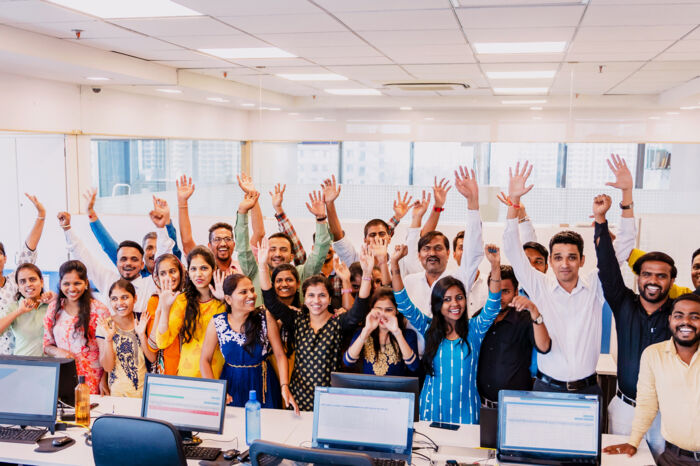
Examples of creative thinking skills and how to nurture them
- Lateral thinking: Encourage talents to adopt a mindset that involves approaching problems from unconventional angles. Try breaking up the components of a problem and then recombine them in a different way to get a novel perspective on an issue.
- Thinking “counterfactually”: This is where you ask questions around the reasons something didn’t or hasn’t happened. Fletcher explains that “unlike brainstorming, [this] activates motor regions in the brain that are non-logical and mostly nonconscious”. He suggests imagining what a potential future competitor in your industry would look like: “Identify one highly anomalous feature of the competitor — and now imagine that you are that competitor. What does your anomalous feature enable you to do in the market? Stretch your horizon as long-term as you can.”
- Visual thinking: Tools that foster visual thinking include mind maps and concept maps, which aid brainstorming, organisation and effective communication of ideas.

Fostering confidence and original thought
It’s a good idea to encourage open and transparent interaction between talents, but some talents may be reluctant to speak up in a group. These people still have incredible ideas and it’s important to help them find their voices.
Try this exercise with your team. Get everyone to write down something they believe should be initiated but are afraid to propose in the group setting. Share these anonymously, and tell team members to take two minutes to imagine that they want the same thing. Then have them motivate a way to incorporate each “want” into the workspace.
Angus Fletcher, writing for the Harvard Business Review in 2022, suggests that this exercise encourages original thinking because, besides developing confidence in circumspect talents, it has three additional benefits for the rest of the team, too:
“One, it empowers subjective bias, which is a logical weakness but a creative strength… Two, the exercise stimulates teams to actively appreciate nonconformity. And three, it primes the brain to value anomalies: the most potent biological source of creative inspiration.”

Efficiency vs Creativity
In “Unshackling the creative business: breaking the tradeoff between creativity and efficiency” (Deloitte Insights), the authors warn that “Almost by definition, scalable efficiency designs creativity out of organisational activities. It prioritises simplification and standardisation as the means to efficiency, prescribing a correct way of doing things for everyone across the organisation.
“Events and behaviours that fall outside these constraints are ‘exceptions’, undesirable and wasteful disruptions to the process. Tightly specified responsibilities and deliverables provide little room for trial and experimentation. Performance metrics for departments, teams, and individuals drive them to reduce waste and increase productivity rather than to experiment with new ideas and approaches. Formal contracts with outside parties and performance agreements among internal groups constrain creative behaviour, as teams have little incentive to (or might be actively prevented from) departing from stipulated norms.”
The authors note that “we can staff projects with a diverse team that pulls together a range of perspectives, backgrounds and skills” but in order for creativity to emerge, “we need to give project teams the space to be creative” and “this additional effort needs to be planned for and funded.”

How to improve creative thinking skills
What does space for planned creativity look like? To cultivate and nurture creative thinking skills within a team, it’s important to provide the following:
- A safe and supportive environment: For creativity to thrive feedback should be supportive, criticism should be constructive, and the team should feel secure enough to take calculated risks. This entails creating a culture that encourages open sharing of ideas, even if they are not fully developed..
- Diversity: The values of diversity, equity and inclusion (DEI) can contribute significantly to a team’s creative thinking. Individuals have different capabilities when it comes to analysis and creativity. A diverse team comprising members with varied abilities, as well as backgrounds, experiences and perspectives is more likely to identify problems and opportunities from novel angles. These insights enrich the creative process, allowing for fresh approaches and a broader range of problem-solving strategies and more innovative solutions.
- Dedicated time for ideation and collaborative brainstorming sessions: Regularly schedule brainstorming sessions to identify problems and generate fresh solutions. Encourage active participation from all team members, promoting an environment where no idea is dismissed outright, no matter how unconventional it may seem.
- Opportunities for experimentation: Creativity often arises through experimentation. Granting talents the time and resources to explore new ideas and approaches is fundamental. Encouraging a culture of “intelligent risk-taking” or "good failure" and learning from mistakes fosters a mindset that values experimentation as a pathway to innovation.
- Time-outs: Regular breaks help clear the mind and rejuvenate creative thinking skills, and often deliver a fresh perspective.
- Playfulness and humour: Creativity thrives in a lighthearted environment. Encourage team members to have fun and embrace playfulness, as humour can spark innovative ideas and foster a positive team dynamic.
- Continuous learning and development: Providing talents with opportunities to acquire new knowledge and develop skills can cultivate a team of more creative thinkers.
- Acknowledgement: Recognising and celebrating the achievements of teams when they generate new ideas is also important. Celebrations fuel motivation, and cohesion, encouraging ongoing creativity and the pursuit of excellence.
Putting strategies like these in place will help establish a vibrant culture of creativity, innovation and problem-solving.




